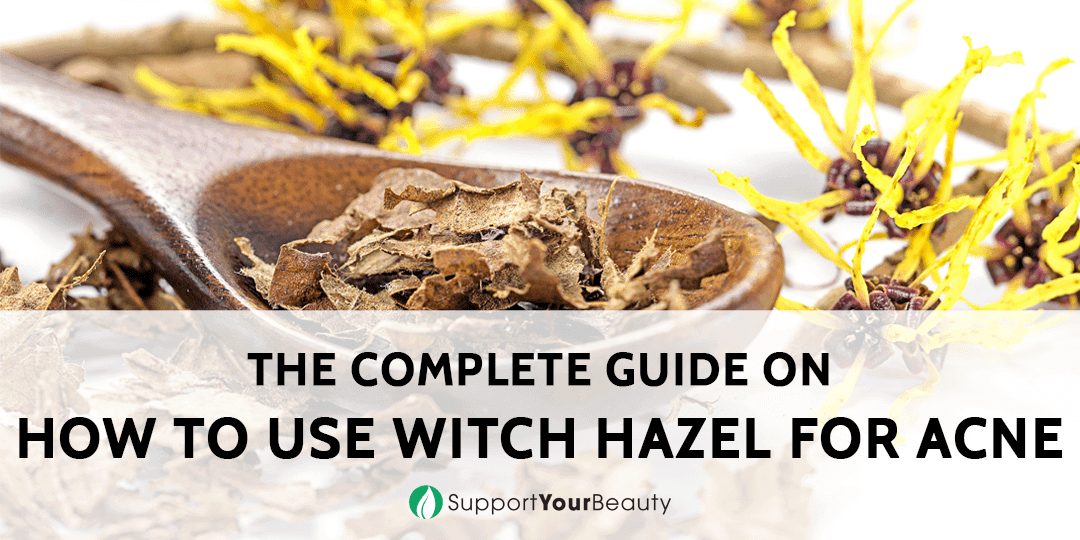
Eager to find out how to use home remedies the best way? Check out our free complete guide on how to get rid of acne now!
At a Glance: True to its magical-sounding name, witch hazel is a natural ingredient that works like magic in curing various ailments, especially those of the skin. Yes, witch hazel can make you look magically good.
Do you remember the very first time you noticed a zit surfacing on your once flawless skin?
Perhaps acne first broke out on your face at a time when puberty was just starting to set in.
And your initial go-to treatment? We guess it was a bottle of astringent that you saw on the pages of one of your mom's beauty magazines.
Buying your first astringent was like a rite of passage, an official initiation into adulthood.
Sure, it was exciting!
But it was also like a scene straight out of a horror movie when you realized that the astringent you used only ruined your skin instead of healing it.
Most astringents that are available in health and beauty stores often contain chemicals that can be too abrasive for you.
Their main ingredient is alcohol that, if undiluted, can cause excessive drying and even permanent damage on your skin.
But that doesn’t mean you have to avoid using astringents for the rest of your life.
All you have to do is choose an all-natural astringent, like witch hazel.
More...
Can Witch Hazel Help Acne?
A good astringent has a lot of benefits for your skin; it can:
- tighten pores
- avoid the overproduction of sebum
- kill acne-causing bacteria that colonizes the pores of the skin and thrives on sebum
Witch hazel, as a natural astringent, reduces the amount of toxins and pollutants that clog the pores---and so much more!
Now let's take a closer look at this magical ingredient first.
Witch hazel (Hamamelis virginiana) is a deciduous shrub that is indigenous to North America.
Although a typical flower-bearing plant, it has many unique characteristics.
For one, it is known to grow flowers even in the middle of winter, hence the nickname winterbloom. Its spider-like flowers range from pale yellow through fiery red and produce a spicy fragrance.
Witch hazel's magical-sounding name is also often the cause of contention.
Contrary to what you might have thought, the word "witch" did not originate from witchcraft. It was from wyche, the Middle English word for "flexible," referring to its pliant bark that was used by British settlers in America for dowsing.
And although it is not an actual hazel plant, the “hazel” in its name was coined because witch hazel’s leaves have a striking resemblance to the American hazelnut (Corylus americana).
Are you disappointed that there isn’t really anything supernatural about witch hazel?
Don’t worry, witch hazel doesn’t come short of magical properties.
History of Witch Hazel - As a First Aid Staple
For hundreds of years, Native Americans used witch hazel as a powerful cure for different ailments, primarily to treat skin sores and tumors.
One of the many ways that Native Americans used witch hazel was as a kind of "magic water"--- an astringent extracted from boiling the bark and leaves of witch hazel.
Different Native American tribes used this solution to alleviate inflammation and swelling of the skin.
In the mid-1800s, Theron Pond (yes, the same “Pond” behind the “Pond’s Extract”) collaborated with the Oneida tribe.
He developed a herbal extract from a shrub that the Oneida used to treat all types of wounds and later marketed it as the "Golden Treasure."
Incidentally, Dr. Charles Hawes, a Connecticut physician, and missionary turned witch hazel into a household first aid staple with his studies of the solution's efficacy.
It was thanks to these developments that you can now readily purchase a bottle of 100% pure witch hazel from your local drugstore to use for your acne.
What Does Witch Hazel Do For Your Skin?
Now let's find out why it is considered to be nature's "power plant."
For starters, witch hazel is very useful in preventing and treating your acne conditions because of its antiseptic, antioxidant, astringent, and anti-inflammatory properties.
Second, witch hazel is very gentle on your skin. It does not strip off all your skin's natural moisture like other acne medications that sometimes contain alcohol.
Commercially distributed witch hazel is prepared through a thirty-six-hour process of distillation, condensation, and filtration.
This process helps break down the plant matter and activate its chemical compounds.
These chemical compounds make witch hazel a natural "power plant" that can treat a myriad of health issues.
They are also the reasons why most skin care experts prefer to use witch hazel for acne.
1. Flavonoids
Free radicals stimulate the sebum that is produced from the pores of your face.
They then turn squalane, an oil that naturally occurs in your body, into squalane peroxide.
You see, squalane peroxide is highly comedogenic: it blocks your pores by triggering an overproduction of sebum.
This excess sebum combines with dead skin cells to clog your pores, making it an ideal breeding ground for acne-causing bacteria.
Witch hazel contains flavonoids. These are antioxidants that help protect plants from the ultraviolet rays of the sun.
When taken or applied on your skin, the flavonoids from witch hazel helps combat free radicals.
They also protect the blood vessels within your dermis that transport oxygenated blood and nutrients that help nourish your skin.
2. Tannins
Witch hazel also produces tannins, which are vital for reproduction and regeneration.
Tannins are polyphenols, compounds that are abundant in natural plant sources and contain antioxidants.
Because they contain antioxidants, tannins in witch hazel help regenerate your cells and help fight off potential damages caused by free radicals.
Tannins also contain antibacterial properties that destroy acne-causing bacteria, such as Propionibacterium acnes (P. acnes) that grow on your pores and thrives on the oil that is released by your sebaceous glands.
3. Astringent
Witch Hazel is a natural astringent that tightens, dries, and hardens tissues.
This astringent property of witch hazel binds and shrinks your pores.
When you use witch hazel for acne, it seals off your pores from contaminants that are present in the environment, which can clog your pores and mix with sebum to incubate acne-causing bacteria.
And like tannins and flavonoids, astringent also contains antioxidants that help regenerate your skin to maintain a youthful look.
How To Use Witch Hazel For Acne
There are many different ways to use witch hazel for acne.
You can either use it as a solution on its own or as an added ingredient to your own anti-acne concoction.
You can even brew it the way you would your favorite tea!
Let us walk you through some of our favorite witch hazel recipes that you can prepare at home to help you get rid of your acne without the irritating downtime.
1. Foaming Facial Cleanser
If you are suffering from acne, chances are you have oily skin.
One way of keeping the sebum production of your face at bay is by using a mild foaming cleanser.
The foamy lather that it creates effectively removes deep-seated dirt and oil that you can get from heavy makeup, sunscreen, and pollutants that your skin is exposed to.
Preparation:
In a foaming soap dispenser (preferably 16 0z), mix two tablespoons of witch hazel with half a cup of Castile soap and ten drops of lemongrass essential oil.
The main ingredient in Castile soap is olive oil, which makes it an extra mild cleanser for your face.
When combined with lemongrass and witch hazel, it becomes a powerful antibacterial and antiseptic foaming cleansing solution that eliminates your acne without drying your face.
Application:
Wet the skin with lukewarm water and gently lather your face with two pumps of the foaming facial cleanser. Rinse off.
2. Clay Mask
Clay masks have been a favorite beauty product among women (and men) for many centuries because of its ability to efficiently distribute the skin-healing properties of its ingredients within the skin.
When applied on your face, clay masks use your skin’s capillaries to absorb substances deep into your pores.
Preparation:
In a bowl, mix two tablespoons of calcium bentonite clay powder, two teaspoons of organic turmeric, two tablespoons of unrefined coconut oil, and two tablespoons of witch hazel.
Stir the mixture well until the powdered ingredients are perfectly diluted.
Calcium bentonite is a natural clay formed from volcanic ash. Liquid activates its negative charge; so when mixed, it becomes a highly porous sponge that absorbs toxins.
Application:
After washing your face, preferably with Witch Hazel Foaming Facial Cleanser, apply the clay mixture and massage gently on your face.
Leave the clay mask to dry for thirty minutes, then rinse with water.
3. Witch Hazel Astringent
Perhaps the most popular use of witch hazel is as a natural astringent.
Being an astringent, when you apply witch hazel on your skin, the tissues that make up the dermis will shrink. This, in turn, diminishes the appearance of scars from your previous acne breakouts.
Its antiseptic properties can help control your acne by reducing inflammation, decreasing the production of sebum, and taming the redness of your lesions.
As an antimicrobial solution, witch hazel halts the growth of bacteria in your pores, thus eliminating the cause of potential breakouts.
Preparation:
Witch hazel extract is readily available in your favorite health and beauty stores, so you don't necessarily have to go through the long process of gathering leaves and barks to brew your own concoction.
As a topical astringent, you can easily apply witch hazel directly on your acne lesions and scars.
Before doing so, however, make sure that you store the entire bottle in a refrigerator.
Once it turns cold, the anti-inflammatory effect of witch hazel heightens. This helps lessen the redness and appearance of your zits, especially in the case of cystic acne.
When you see the first signs of a breakout, don’t hesitate to apply your witch hazel astringent directly to the area.
This can stop the pimple from getting any bigger and will instead help it to heal faster.
Application:
After washing your face with your Witch Hazel Foaming Facial Cleanser, saturate a cotton ball with witch hazel essence.
Slowly, dab the cotton on your face, focusing on areas where your acne is more rampant.
Do this in the morning and again in the evening. You’ll be able to see improvements in your acne condition within two weeks of continuous use.
The Bottom Line
There you have it - a complete guide on how to use witch hazel for treat your acne problems!
As with any skin problem, the best defense is a good offense. Instead of thinking only of a cure to your acne, it is best to prevent them from happening in the first place.
And how do you prevent the plague of pimples? Well, you can start by following the three cardinal rules of a healthy skin:
- Live a healthy lifestyle
- Avoid exposure to pollutants
- Observe a healthy skin care regimen
But when acne has taken its toll, you can always resort to a little ‘magic’ to banish your nasty zits.
For one, skip harsh acne products, like alcohol-based astringents, and turn instead to witch hazel.
Witch hazel may not be a product of a book of spells, but by taming your acne flare up without drying your face, rest assured that it is never short of magical.

